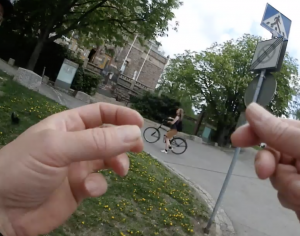Art and Activism Constructing Urban Sensory Environments
During a sensobiographic walk urban experiences are composed of sensed environment, individual and collective memories and remembering, which are then shared with the fellow walkers participating to research.
With this in mind two walks were carried out in Spring 2018 in Turku, Finland, with two participants and a researcher documenting the discussion. Both walkers had a background in artistic work, artistic interventions and activism related to political decision-making, especially in the context of accessibility of art and how this all relates to issues such as sharing of public funds and how they are channelled not only locally and nationally but also within the European community.
The participants tackled themes such as artistic interventions and how EU-subsidized and grassroots artistic interventions were constructing common urban environment – and how certain political and artistic views tended to collide. Also, topobiographical descriptions referring to the walkers’ life-courses as it relates to lived places enabled transfer of knowledge on traditions, beliefs and behaviours from one generation to another thus contributing to transgenerational nature of the walks.
An aging informant described the acts of activism in the 1960s taking place in local park, next to the Turku Art Museum. Turku activists called themselves situationists after their French contemporaries. Situationists International was a transnational organization of social revolutionaries, a collective of avant-garde artists and intellectuals prominent in Europe from 1957 to 1972. Their goal was to change society by provocations and mainly artistic interventions, that a group of people could experience in a given place at a given time.

Sensobioraphic view to Turku Arts Museum
To some extent this took place in Turku, too. According to a Sensotra participant the Turku situationists had puzzling slogans such as “Hooray for what?’ [Eläköön mimmoinen?] and “If you go somewhere, you can expect anything”. [Jos menet jonnekin, voit odottaa mitä tahansa.] The act of repainting signs in the park was described as follows: “Then we painted ´Please keep off the grass’ signs. We collected them at night and with a couple of artists painted new slogans and then brought the signs back again. It didn’t have much effect, though. City workers collected them in the Autumn and brought them back the next Spring. They practically circulated the ones we had painted!”
Situationist International was a movement, which was afraid of recuperation. Their fundamental fear was that the situationists’ ideas would be first trivialized and sterilized, and then they’d be safely incorporated back within mainstream society, where they can be exploited to add new flavours to old dominant ideas. In retrospect, it looks like that Turku situationists were not necessarily afraid of recuperation, but perhaps slightly amused of it.
The act of remembering occurred in given places meaningful to sensobiographic walkers. In this specific context multifaceted definitions of place could benefit from Edward Casey’s ideas, which make the relationship to physical places utterly dynamic: culture is carried into places by bodies. Thus, memories of individuals are connected to factual events and places become layered ethnographic histories of a given urban environment.
Furthermore, as part of the data analysis and in support of sensobiographic research, it is possible to combine the information generated by walking method with the social and cultural history of a particular place and area.
—
Dr. Heikki Uimonen, Principal investigator (ACMESOCS) and Project researcher (SENSOTRA), University of Eastern Finland